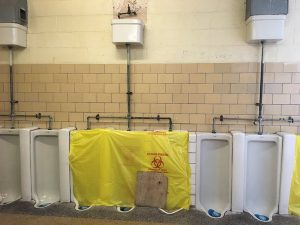Recently, I spent the day observing two student teachers. Both were teaching instrumental music in middle and high schools, and each was assigned to an experienced, master teacher. But that’s where the similarities end…
One of the student teachers was placed in an urban school and the other in a rural school. The differences between these two schools were stark, and illustrative of the disparities in how our society treats children based on their socioeconomic status.
Upon entering the urban school, I was immediately struck by how quiet it was. The hallways were eerily empty, with none of the typical hallway chatter and vibrancy of excited students making their way from class to class. The corridors were dark and gloomy, with the walls and lockers looking badly beat up and in need of a fresh coat or two of paint. A quick trip to the men’s restroom revealed a dirty, broken mirror, no soap, and a single roll of paper towels propped up on the edge of a cracked porcelain sink with a leaky faucet. The restroom, like the halls and classrooms, hadn’t been cleaned in a long time.

Less than an hour later I found myself 20 miles away in a bustling school with busy hallways flooded with natural light, brightly painted walls and lockers, and large classrooms with freshly vacuumed, plush carpeting. The restroom was spotlessly clean, and fully stocked with soap dispensers, paper towels and hot air hand dryers.
While the contrasts between these schools could not have been more clear, the students in each building were amazingly similar. Both bands were beautifully behaved, engaged and enthusiastic. Each group of musicians entered their respective band room, got their instruments out of their cases, and began warming up for rehearsal. It was only upon closer examination and discussion that the differences between these two settings became more readily apparent:
- In the rural school, every child had their own instrument, and kids who played large instruments like the tuba had one school-owned instrument to play at school, and another instrument for home practice; in the urban school, some instruments were shared among multiple students during the day, and no students had school-owned instruments at home.
- All of the instruments in the rural school were in good playing condition, and when repairs are required there is a school budget and an established repair procedure in place; the teacher in the urban school was busy re-padding a clarinet when I entered the band room, and shared that she spends over $1000–out of her own pocket–per year on instrument repairs and equipment replacement. There is virtually no school budget for these things.
- Most of the students in the rural school’s high school band had been playing their instruments since 5th grade, and had lived in that community their entire lives. The 112-piece band played advanced repertoire, had a full instrumentation, and many of the band’s alumni went on to participate in music ensembles in college after graduation; the urban school’s band program had been decimated by the elimination of the district’s elementary music program the previous year, and as a result there were only 15 students in the ensemble. Due to the transient nature of the school’s population, students who had been playing their instruments for several years were sitting next to kids who had just started playing two weeks previously, making for a very challenging learning environment for students and teachers alike.
Driving home at the end of the day, I couldn’t help but wonder how different things would be if all of these children, both rural and urban, had the same advantages at school–clean, safe and adequate facilities; high-quality instruments in good working condition; vibrant, attractive surroundings conducive to learning.
I wondered what a student from the urban school would think if she spent a day at the rural school, in a bright, spacious and well-maintained environment. Would she feel angry, knowing that her peers in the rural school district had advantages that were denied her?
And I wondered what it says about us as a society that we allow some of our children to spend their school days in squalid conditions that make learning more difficult, while their peers in more affluent communities enjoy advantages that help prepare them for success.




